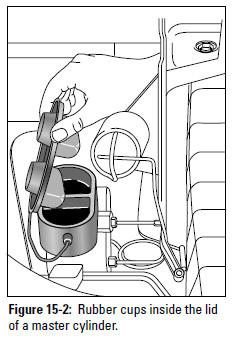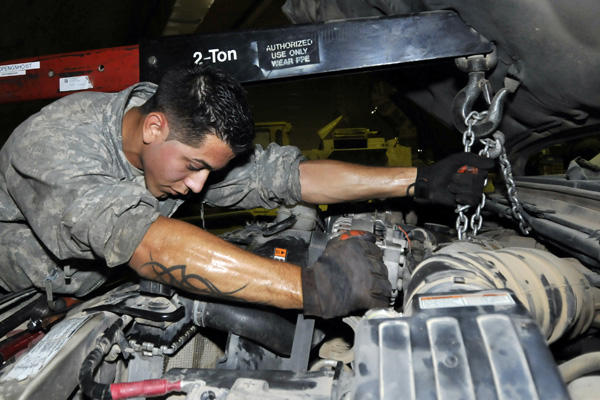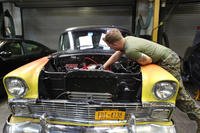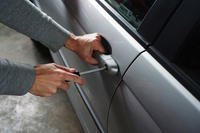Brake fluid is stored in the master cylinder. When you step on the brake pedal, fluid goes from the master cylinder into the brake lines; when you release the pedal, the fluid flows back into the master cylinder. Essentially, when you check your master cylinder, you're making sure that you have enough brake fluid.
Caution: If your vehicle has ABS, consult your owner's manual before checking the master cylinder. Failure to do so may result in under- or over-filling the reservoir. And remember that some ABS are under extreme pressure and should be handled professionally.
To check the brake fluid in your master cylinder, follow these steps:
- Open the brake fluid reservoir on top of your master cylinder.
If you have the kind with a little plastic bottle on top, just unscrew the cap on the little plastic bottle that sits on top of the master cylinder (see Figure 15-1). (Some master cylinders have a cap for each chamber.) If you have a metal reservoir, use a screwdriver to pry the retaining clamp off the top (also shown in Figure 15-1).
Caution: Don't let any dirt fall into the chambers when you open the lid. If your hood area is full of grime and dust, wipe the lid before you remove it.

- Take a look at the lid.
Attached to the inside surface of the lid is a protective diaphragm with rubber cups (see Figure 15-2). As the brake fluid in your master cylinder recedes (when it's forced into the brake lines), the diaphragm cups are pushed down by air that comes in through vents in the lid. The cups descend and touch the surface of the remaining brake fluid to prevent evaporation and to keep the dust and dirt out. When the fluid flows backin, the cups are pushed back up.
Tip: If your brake fluid level is low, or if the cups are in their descended position when you remove the lid, push them back up with a clean finger before you replace the lid.
Caution: If the cups seem very gooey or can't be pushed back to their original position, the wrong brake fluid may have been used. Because some power steering fluid reservoirs are the same shape as the brake fluid reservoirs in master cylinders, there have been cases where power steering fluid was accidentally installed in the master cylinder. If this happens, everything but the steel brake lines must be rebuilt or replaced, including the master cylinder!

- Look inside the master cylinder.
The brake fluid should be up to the "Full" line on the side of the cylinder or within 1⁄2 inch of the top of each chamber. If it isn't, buy the proper brake fluid for your vehicle and add it until the level meets the line.
Caution: Be sure to read the "Flushing and Changing Brake Fluid" section in this chapter to ensure that you buy the proper kind of brake fluid. Also remember to close the brake fluid reservoir as quickly as possible so that oxygen or water vapor in the air doesn't contaminate the fluid. And try not to drip it on anything — it eats paint!
A low brake fluid level may not mean anything if it's been a long time since any fluid was added and if your vehicle has been braking properly. If you have reason to believe that your brake fluid level has dropped because of a leak, use this chapter to check the rest of your system very carefully for leaks.
- If both chambers of your master cylinder are filled with brake fluid to the proper level, close the master cylinder carefully, without letting any dirt fall into it.
If dirt gets into your master cylinder, it will travel down the brake lines. If it doesn't block the lines, the dirt will end up in your wheel cylinders and damage your brakes.
- Brake fluid evaporates easily, so don't stand around admiring the inside of your master cylinder. Close it quickly, and be sure that thelid is securely in place.
Caution: Because most master cylinders are pretty airtight, you shouldn't lose brake fluid in any quantity unless it's leaking out somewhere else. If your fluid level was low, you'll find the cause as you continue to check the system.
- Use a flashlight or work light to look for stain marks, wetness, or gunk under the master cylinder and on whatever is in its vicinity.
If your master cylinder is — or has been — leaking, you'll see evidence of it when you look closely.
Tip: It's a good idea to check your master cylinder at least every couple of months — more often if it was low in fluid when you last checked it.
From Auto Repair for Dummies, copyright © 2009 by Wiley Publishing, Inc., Indianapolis, Indiana. Used by arrangement with John Wiley & Sons, Inc.












